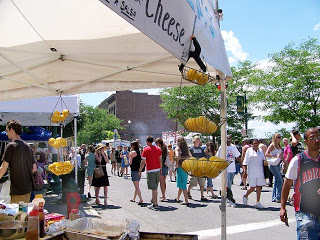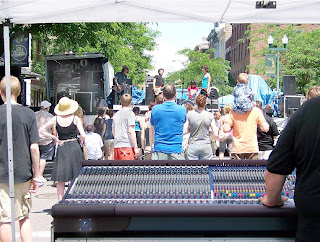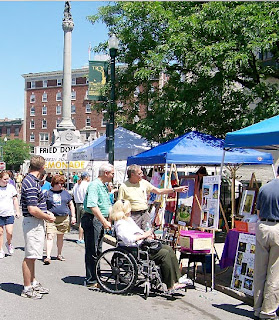Photos by April L. Dowd
(Double-click to enlarge images)

In some cities street festivals are weekly events. In the Capital Region they’re far less frequent, but can be every bit as much of a crowd pleaser.
The annual River Street Festival in Troy was such a place on Saturday, June 16, another sign that the gradual but perceptible revival of the waterside city is working.
Thousands — some city officials claim 20,000 over the course of the day-long event — crowded River Street from just north of City Hall down several blocks into the Antiques District, with live music at either end. Food and craft vendors lined both sides of the street, along with strollers, dogs, kids and people looking for a spot of shade in the glare of a near-90 day.
This is what a lot of Troy must have looked like many years ago, with crowds milling about, lots of pleasant noise, and folks just generally having a good time. It’s what you hear when oldtimers reminisce about the city’s heyday.
There will be more such, if repeated comments I overheard by non-Troy residents are any indication. Things like, “The architecture down here is fantastic. I want to come back.” “I always thought it was hard to find your way around Troy. It’s easy and they have loads of parking.” “Let’s come back next week and try the antiques shops.”
Larry Schepici isn’t wasting any time trying to keep the momentum going. The much-decorated chef who owns two downtown establishments — the Illium Cafe on Monument Square and the fine-dining Tosca just a few steps away — told me he’s planning a Troy Chowderfest competition on Saturday, Aug. 18, that might cordon off another part of River Street: the food-and-fun block just above the Green Island Bridge where Jose Malone’s, Ryan’s Wake, Deli-icious, River Street Cafe, Troy Brew Pub and Revolution Hall are located.
“There’s no reason to limit ourselves to just once in a while,” Schepici said. “We’ve got something going here and we need to take advantage of the momentum.”
The concept of the event, Schepici said, is to feature Troy restaurants working with local farms and produce to showcase the relationship between chefs and the farms of
the Capital Region.
Luckily, Troy hasn’t blocked itself off from the Hudson River as its downstream neighbors in Albany did when I-787 was constructed on the west bank. Its proximity to water, affording ambiance and views, is among the major drawing cards luring condo builders, redevelopers and businesses to the Rensselaer County side.
This all may sounds like a very hopeful pronouncement, especially from the guy who christened Troy “Plywood City” in frustration over the number of derelict, boarded-up buildings that create pockets of eyesores throughout a community on the comeback trail. But both views have been rooted in reality.
Where once there were few signs of revival, we now see redevelopment of former factory and commercial buildings, planning for the massive Congress Street corridor project, and new buildings at RPI popping up like toadstools after a warm rain.
It’s fair to say Troy no longer is just a place you drive through to get to Vermont.
(Posted 06/17/07)
Connect here with columnist William M. Dowd’s lineup of blogs for news and information on food, drink and destinations.





